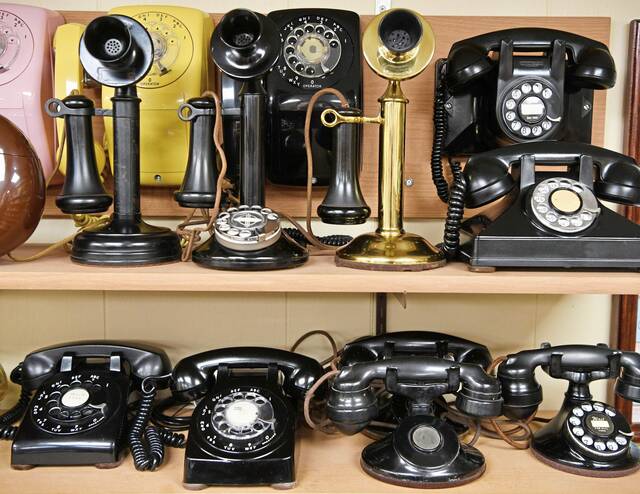https://triblive.com/news/world/rip-landline-phones-if-you-dont-have-one-now-you-may-not-be-able-to-get-one/
RIP landline phones? If you don't have one now, you may not be able to get one

When Andy Brady had his cable television service installed, a landline telephone number was part of the package deal. He’s never hooked a phone to it, though.
That probably says something about the bleak future for landline phones, considering Brady is the market president for the Verizon Consumer Group’s Great Lakes market.
“We’ve seen about 24% of people in Pennsylvania who’ve fully done away with their landlines and gone wireless,” Brady said.
According to the Pennsylvania Public Utility Commission, there are just under 2.6 million residential landlines in service in Pennsylvania. That figure was 4 million in 2020 and nearly 5 million in 2015.
From 2010 to 2020, the percentage of Pennsylvanians with cellphones went from 18.4% to 51.4%, according to the National Center for Health Statistics.
Verizon competitor AT&T previously had announced a phase-out of its copper-wire-based analog system by the end of this decade and already has begun that process in neighboring Ohio.
In three filings this year, AT&T notified the Public Utilities Commission of Ohio it no longer will offer new basic local exchange service to homes and businesses in 248 locales in the state.
“We have newer, high quality voice services available that may be less expensive, so we’re no longer offering copper-based landline service to new customers in certain areas,” AT&T spokesman Phil Hayes said.
For now, those with copper landlines can keep and use them, but AT&T wants to exit the copper network in most areas by 2030.
And they’re not the only company clipping the copper line. Others, such as Verizon and CenturyLink, are doing the same, in favor of fiberoptic cables, satellite and voice-over-internet protocol delivery systems.
“We’re seeing more of an evolution in how the technology is used,” Verizon’s Brady said. “I use the internet at my house as a fulcrum for what I want to do on the TV and the computers, and I don’t have a landline in my office in Chicago. Everything is either voice-over-video or cellular, which is voice-over-internet.”
Every phone call Brady makes nowadays is essentially a digital packet of information run through the internet.
The pros of modern systems are many in today’s digital world — mobility, software, compatibility and reduced vulnerability. One benefit of copper lines, though, is they work even during a power outage. So whether the end of copper landlines is a good thing can be debated.
Those kind of lines have been around since shortly after Alexander Graham Bell uttered, “Mr. Watson, come here; I want to see you,” in the world’s first phone call March 10, 1876.
And with those copper landlines, the home phone became an integral part of life itself — a piece of Americana for the Greatest and Silent generations, Baby Boomers and even some Gen Xers.
Feeling sentimental? AT&T wants to hear from you
Those copper lines, which convert sound waves into an electric signal, before it’s converted back into sound waves on the receiving end, haven’t changed much.
But the phone units evolved through the years. Early candlestick-styles with short receiver cords were replaced by rotary then touch dial tabletop and wall-mounted varieties with longer cords. By the 1950s, the standard drab black-colored phone became available in assorted colors, such as green, yellow, blue and beige. Then, in the 1980s, the introduction of cordless phones served as the precursor to cellphones.
To this day, many can still remember their childhood home phone number, their first phone number or the number of a sweetheart.
Hayes said AT&T appreciates the sentiment. But he also pointed out that newer offerings, such as AT&T Phone-Advanced, and even wireless, allow customers to keep their old phone number.
The company has embraced home phone nostalgia with its “Every number tells a story” campaign.
“We memorized our phone number as school children in case of emergencies. We scribbled it on scraps of paper to share with friends. We knew that grandma kept it near the phone in the kitchen so that she could call on our birthday,” the campaign’s web page states.
“So if your readers have a landline number they just can’t forget — a memory they want to keep alive — AT&T wants to hear it,” Hayes said.
To submit a personal story, which could ultimately become part of the company’s official archives, you can call a special hotline at 855-551-2662 or submit it online at attconnects.com/everynumber.
The virtual ‘home phone’
For new Verizon customers, Brady said there are three options. They can have a typical landline installed. They can use Verizon Home Connect, which is basically a cellphone that connects to standard cordless phone handset.
But the most recent option is more of a virtual “home phone,” he said.
“The thing we’ve been pushing now is our Verizon Family Perk, which creates a voice-over-internet phone call where you have a dedicated phone line you’d give to, say, your child’s school or the water company. And that number can be programmed to five different devices at the same time.”
In the same way anyone in the house could answer a call on the landline, anyone on the company’s Family Perk plan will get calls made to the “home phone” number.
“It’s a ‘virtual home phone’ that goes everywhere with you,” Brady said. “At the end of the day, this gives you the ability to answer ‘home’ phone calls wherever you’re at.”
TribLive staff writer Patrick Varine contributed to this report.
Copyright ©2025— Trib Total Media, LLC (TribLIVE.com)
